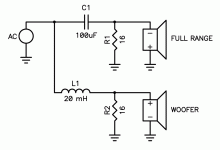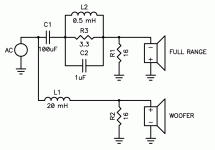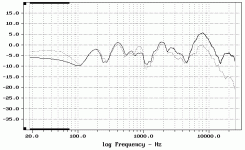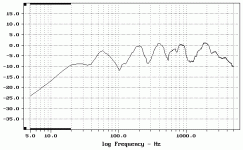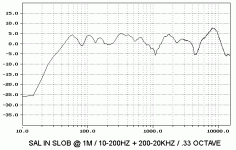Hello Zen, I've read the article and the reason a non discontinued jfet was chosen.did you read article?
edit:
I should add i skimmed trough sweet spot check out article without finding a mention to the single ended buffer optimization or buffer pair matching (to my limited knowledge).
Last edited:
Ok i reskimmed and saw where you directed me Zen
I was blind to the apx assisted matching ; because ; i do not have a unrestricted access to such a device!
So the procedure would be first match for Igs then probe for the sweet spot adjusting R1 and R2 with a distortion analyzer.
Edit:
Did i understood correctly?
I was blind to the apx assisted matching ; because ; i do not have a unrestricted access to such a device!
So the procedure would be first match for Igs then probe for the sweet spot adjusting R1 and R2 with a distortion analyzer.
Edit:
Did i understood correctly?
tell us which exact type of JFets you intend to use , so maybe we can help with more precise answers
tell us which exact type of JFets you intend to use , so maybe we can help with more precise answers
I intend to use 2sk117's GR's
Last edited:
So the procedure would be first match for Igs then probe for the sweet spot adjusting R1 and R2 with a distortion analyzer.
I select for Vp (pinch-off voltage) and then test for the Ids, Vds and RL
which gives the best results. (RL = load resistance)
Hi
I've just built a balanced version of the Lxmini analogue crossover, using kits from the DIYAudio store.
A (naive?) question. As only 5% capacitors are used, won't frequency response differences between the”+” and “-“ boards cause an increase in distortion? Would I be better off using a single board with suitable bal to se, and se to bal conversion at the input and output respectively?
Thanks
Paul N
I've just built a balanced version of the Lxmini analogue crossover, using kits from the DIYAudio store.
A (naive?) question. As only 5% capacitors are used, won't frequency response differences between the”+” and “-“ boards cause an increase in distortion? Would I be better off using a single board with suitable bal to se, and se to bal conversion at the input and output respectively?
Thanks
Paul N
Hi
Does anyone know when a crossover for the lxmini +2, and lxmini + LXstudio will become available in the store? Will it surplant the present crossover? My new lxminis are superb in most respects, but after using a 12” full range driver- Hammer Dynamics Super 12's- I'm running into problems which partially relieving the existing woofers will solve
Thanks
Paul N
Does anyone know when a crossover for the lxmini +2, and lxmini + LXstudio will become available in the store? Will it surplant the present crossover? My new lxminis are superb in most respects, but after using a 12” full range driver- Hammer Dynamics Super 12's- I'm running into problems which partially relieving the existing woofers will solve
Thanks
Paul N
As far I understand the only place for the ASP for LXMini+2 is the Magiklx521 website.
They propose the kit with PCB, JFets and alu enclosure or the whole ASP already populated and tested.
https://www.magiclx521.com/epages/17940394.sf/en_GB/?ObjectPath=/Shops/17940394/Products/%22ASP%20mini%20NP%22/SubProducts/%22ASP%20mini%20NP%20pcb%20set%22
They propose the kit with PCB, JFets and alu enclosure or the whole ASP already populated and tested.
https://www.magiclx521.com/epages/17940394.sf/en_GB/?ObjectPath=/Shops/17940394/Products/%22ASP%20mini%20NP%22/SubProducts/%22ASP%20mini%20NP%20pcb%20set%22
A (naive?) question. As only 5% capacitors are used, won't frequency response differences between the”+” and “-“ boards cause an increase in distortion?
No.
What you might investigate though is the output configuration of your source/preamp to verify it has active signal from the inverted output. (Many "balanced" sources do not.)
If that is the case then your second set of boards was a waste of money.
Dave.
Hi Dave
Thanks. Good, but I don't understand why not. I'll ty to address my ignorance 🙂
My dac is a Twisted Pear Buffalo III Pro 28 SE, using an ES9028 Pro which has a balanced output. I use a couple of single SEN I/V stages with this, in the same way as the crossovers. So I would say yes. Am I right?
Thanks
Paul
Thanks. Good, but I don't understand why not. I'll ty to address my ignorance 🙂
My dac is a Twisted Pear Buffalo III Pro 28 SE, using an ES9028 Pro which has a balanced output. I use a couple of single SEN I/V stages with this, in the same way as the crossovers. So I would say yes. Am I right?
Thanks
Paul
Paul,
Some slight variations in component matching might translate to minor amplitude differences between +/- and/or L/R, but I would not call that distortion, per se. You might be able to measure the differences on the test bench, but you're certainly not going to hear it.....in my opinion.
Your source configuration sounds fine.
My point in that regard is that some equipment (not yours) with balanced/XLR outputs does not have active signal on the inverting output. If that were the case, the portion of the balanced ASP dedicated to processing the "-" signal would not be doing anything.
Dave.
Some slight variations in component matching might translate to minor amplitude differences between +/- and/or L/R, but I would not call that distortion, per se. You might be able to measure the differences on the test bench, but you're certainly not going to hear it.....in my opinion.
Your source configuration sounds fine.
My point in that regard is that some equipment (not yours) with balanced/XLR outputs does not have active signal on the inverting output. If that were the case, the portion of the balanced ASP dedicated to processing the "-" signal would not be doing anything.
Dave.
Thanks a lot Nelson for this wonderful kit and also thanks for posting the
MicroCap sim file, which makes it simple and fun to tweak just a little (or a lot).
I guess I'm doing the latter by thinking of using the whole kit as a hi-pass only to my Quads--- dipole bass part is already built and using the op-amp (LM4562) based (24 dB/octave) filtering implemented in the Linkwitz LX521 ASP.
By replicating the hi-pass components from the midrange/treble hi-pass (27.5 K and 10 nF) to both hi-pass stages on the board and connecting them in series I get a LR4 filter at roughly 120 Hz (changing 10 nF to 49.2 nF) which matches the Linkwitz LX521 cross-over frequency.
This still leaves me with two 'free' buffer stages for possible fine-tuning in the mid-range/treble region.
Thanks again!
/M
MicroCap sim file, which makes it simple and fun to tweak just a little (or a lot).
I guess I'm doing the latter by thinking of using the whole kit as a hi-pass only to my Quads--- dipole bass part is already built and using the op-amp (LM4562) based (24 dB/octave) filtering implemented in the Linkwitz LX521 ASP.
By replicating the hi-pass components from the midrange/treble hi-pass (27.5 K and 10 nF) to both hi-pass stages on the board and connecting them in series I get a LR4 filter at roughly 120 Hz (changing 10 nF to 49.2 nF) which matches the Linkwitz LX521 cross-over frequency.
This still leaves me with two 'free' buffer stages for possible fine-tuning in the mid-range/treble region.
Thanks again!
/M
...and blushing I have to correct myself, LR4 R-C values are NOT the same as using LR2 R-C values twice.
27K, 54K and 34.5 nF are the correct LR4 120 Hz hi-pass values (see formulas on linkwitzlab.com)
27K, 54K and 34.5 nF are the correct LR4 120 Hz hi-pass values (see formulas on linkwitzlab.com)
Last edited:
Questions for the forum. I am totally new to speaker building, my focus has been on the electronics.
I am planning on building Dick Olsher's OB3, finally got the necessary speakers in hand. I have emailed Dick regarding using the LX mini crossover with the necessary changes in component values to work with the OB3 design. Dick uses a passive crossover system, I am leaning towards bi-amping via the LX mini crossover. Dick feels that would not be possible or desirable.
So, I am interested in thoughts going down the active path versus the passive. Additionally if the active path will work, what I don't know/understand is how to reverse engineer the passive crossover specs in order to know what components I would need in the LX mini setup. I realize the microCap simulation will help with that.
Not sure if I am explaining myself well. Here is the link to the OB3 Tip_85
Thanks
David
I am planning on building Dick Olsher's OB3, finally got the necessary speakers in hand. I have emailed Dick regarding using the LX mini crossover with the necessary changes in component values to work with the OB3 design. Dick uses a passive crossover system, I am leaning towards bi-amping via the LX mini crossover. Dick feels that would not be possible or desirable.
So, I am interested in thoughts going down the active path versus the passive. Additionally if the active path will work, what I don't know/understand is how to reverse engineer the passive crossover specs in order to know what components I would need in the LX mini setup. I realize the microCap simulation will help with that.
Not sure if I am explaining myself well. Here is the link to the OB3 Tip_85
Thanks
David
Act vs passive XO
Hallo David
A passive XO has a measurable transfer function.
It might be possible to replicate this in an active XO. Can be tedious work.
Changes in XO are usually easiest / quickest varied with a DSP.
(But with caution i.o. not to blow drivers)
Of course you may switch to ASP when coming close to your target.
Best
Frank
Hallo David
A passive XO has a measurable transfer function.
It might be possible to replicate this in an active XO. Can be tedious work.
Changes in XO are usually easiest / quickest varied with a DSP.
(But with caution i.o. not to blow drivers)
Of course you may switch to ASP when coming close to your target.
Best
Frank
Last edited:
I have some data on this.
First, here is the passive crossover and the passive crossover with
a top end notch filter, both with OB's using the Eminence 15" Definimax,
and the curves for the top end with and without the notch, and lastly
the curves for the bottom end.
First, here is the passive crossover and the passive crossover with
a top end notch filter, both with OB's using the Eminence 15" Definimax,
and the curves for the top end with and without the notch, and lastly
the curves for the bottom end.
Attachments
Thank you Nelson and Frank. This will give me something to mull over. Nelson, I was able to score some of the last stock of Hawthorne Augie 15" woofers and a pair of SAL fullrange from a forum member.
Dick does indicate the part values needed for the OB3 which is where I am headed. Would the SLOB information with the SAl and Augie pair get me in the ballpark?
Thanks
David
Dick does indicate the part values needed for the OB3 which is where I am headed. Would the SLOB information with the SAl and Augie pair get me in the ballpark?
Thanks
David
Would the SLOB information with the SAl and Augie pair get me in the ballpark?
I should think so. Doesn't have to be the SLOB, but an OB with those
dimensions will be helpful. Do check out the curves of the B5 for this
in the owner's manual.
- Home
- Amplifiers
- Pass Labs
- LX-mini Crossover Article
